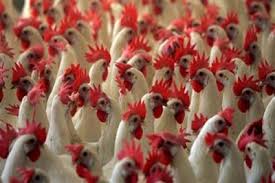China tried to ease concerns that a new strain of bird influenza will spark an epidemic as authorities reported three more infections of the deadly H7N9 virus that’s killed six people since March.
“We are confident of dealing with this effectively,” Ma Xiaowei, a vice minister at the National Health and Family Planning Commission, said in an interview in Beijing yesterday. “We have adequate amount of anti-flu medicines, and we have also started to study the production of vaccines.”
The outbreak of the virus caused soybean futures and Chinese stocks to fall on April 5 amid concerns the disease will hurt demand in the world’s second-largest economy. The three new reported infections raised the total of cases to 21.
“Right now we see no risk of human-to-human transmission and we hope that will remain the case,”Michael O’Leary, China representative of the World Health Organization, told reporters in Beijing yesterday. “But we have to follow that very closely because the virus could change.”
Chinese health authorities notified the World Health Organization of an additional three laboratory-confirmed cases of human infection, the Geneva-based body said. Two of those cases were residents of Shanghai while the third was a 55-year- old man from Anhui, now in stable condition, it said.

Here’s something to watch and not just for the value your portfolio. Over the weekend Bloomberg reported that:
The new bird influenza that’s killed six people in eastern China has some of the genetic hallmarks of an easily transmissible virus, according to the scientist who showed how H5N1 avian flu could become airborne.
The H7N9 strain, which is a new virus formed as a result of two others merging their genetic material, has features of viruses that are known to jump easily from birds to mammals, and a mutation that may help it attach to cells in the respiratory tract, saidRon Fouchier, a professor of molecular virology at Erasmus Medical Center in the Netherlands, in a telephone interview yesterday.
“That’s certainly not good news,” said Fouchier, who reviewed a gene sequencing of H7N9 published by Chinese health authorities. “This virus really doesn’t look like a bird virus anymore; it looks like a mammalian virus.”
To curb the spread of H7N9, Shanghai, Hangzhou and Nanjing, cities with confirmed human cases of the virus, have halted trading in live poultry, closed bird markets and slaughtered more than 20,000 fowl. Shanghai today reported two new infections, taking China’s tally to 18, according to data compiled by Bloomberg News from reports released by the national and provincial governments.
The outbreak caused soybean futures and airline stocks to fall yesterday on concern the virus may spark a pandemic.
While there’s no evidence yet of human-to-human transmission, scientists are scrutinizing the virus’s genetic makeup for clues to the threat it may pose.
Fouchier authored a study last year that showed five genetic tweaks to the deadly H5N1 virus, which has killed more than 600 people since 2003, made it airborne in ferrets, the mammals whose response to flu most closely resembles that of humans.
One of the mutations he made is in an enzyme called polymerase; another was in a protein called hemagglutinin on the surface of the virus. H7N9 has both mutations, he said.
“This virus is certainly of more concern than the vast majority of bird flu viruses,” Fouchier said. “Most bird flu viruses that we know do not have these mutations.”
Whether those mutations alone are enough to make the virus easily transmissible isn’t clear, and should be “high on the research agenda,” Fouchier said. Still, there’s no evidence yet that the virus is more likely to become more dangerous than H5N1, he said.
“Even if we see relatively high numbers of human cases, it doesn’t mean a pandemic is imminent,” he said. “H5N1 has circulated for 16 years and not become mammal-to-mammal transmissible.”
This morning China has said that:

